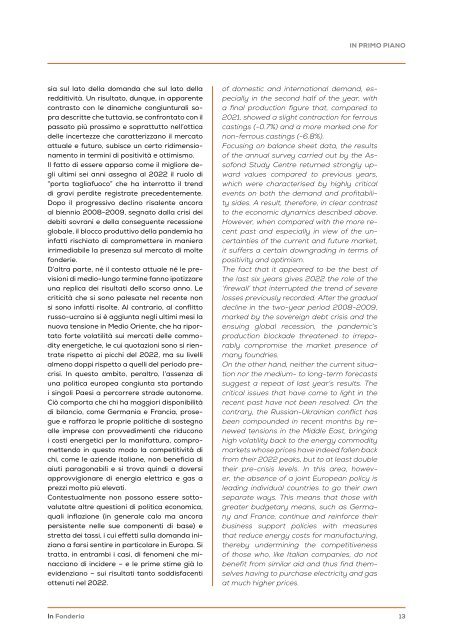In Fonderia 6 2023
Sesto numero del 2023 di In Fonderia
Sesto numero del 2023 di In Fonderia
Create successful ePaper yourself
Turn your PDF publications into a flip-book with our unique Google optimized e-Paper software.
IN PRIMO PIANO<br />
sia sul lato della domanda che sul lato della<br />
redditività. Un risultato, dunque, in apparente<br />
contrasto con le dinamiche congiunturali sopra<br />
descritte che tuttavia, se confrontato con il<br />
passato più prossimo e soprattutto nell’ottica<br />
delle incertezze che caratterizzano il mercato<br />
attuale e futuro, subisce un certo ridimensionamento<br />
in termini di positività e ottimismo.<br />
Il fatto di essere apparso come il migliore degli<br />
ultimi sei anni assegna al 2022 il ruolo di<br />
“porta tagliafuoco” che ha interrotto il trend<br />
di gravi perdite registrate precedentemente.<br />
Dopo il progressivo declino risalente ancora<br />
al biennio 2008-2009, segnato dalla crisi dei<br />
debiti sovrani e della conseguente recessione<br />
globale, il blocco produttivo della pandemia ha<br />
infatti rischiato di compromettere in maniera<br />
irrimediabile la presenza sul mercato di molte<br />
fonderie.<br />
D’altra parte, né il contesto attuale né le previsioni<br />
di medio-lungo termine fanno ipotizzare<br />
una replica dei risultati dello scorso anno. Le<br />
criticità che si sono palesate nel recente non<br />
si sono infatti risolte. Al contrario, al conflitto<br />
russo-ucraino si è aggiunta negli ultimi mesi la<br />
nuova tensione in Medio Oriente, che ha riportato<br />
forte volatilità sui mercati delle commodity<br />
energetiche, le cui quotazioni sono sì rientrate<br />
rispetto ai picchi del 2022, ma su livelli<br />
almeno doppi rispetto a quelli del periodo precrisi.<br />
<strong>In</strong> questo ambito, peraltro, l’assenza di<br />
una politica europea congiunta sta portando<br />
i singoli Paesi a percorrere strade autonome.<br />
Ciò comporta che chi ha maggiori disponibilità<br />
di bilancio, come Germania e Francia, prosegue<br />
e rafforza le proprie politiche di sostegno<br />
alle imprese con provvedimenti che riducono<br />
i costi energetici per la manifattura, compromettendo<br />
in questo modo la competitività di<br />
chi, come le aziende italiane, non beneficia di<br />
aiuti paragonabili e si trova quindi a doversi<br />
approvvigionare di energia elettrica e gas a<br />
prezzi molto più elevati.<br />
Contestualmente non possono essere sottovalutate<br />
altre questioni di politica economica,<br />
quali inflazione (in generale calo ma ancora<br />
persistente nelle sue componenti di base) e<br />
stretta dei tassi, i cui effetti sulla domanda iniziano<br />
a farsi sentire in particolare in Europa. Si<br />
tratta, in entrambi i casi, di fenomeni che minacciano<br />
di incidere – e le prime stime già lo<br />
evidenziano – sui risultati tanto soddisfacenti<br />
ottenuti nel 2022.<br />
of domestic and international demand, especially<br />
in the second half of the year, with<br />
a final production figure that, compared to<br />
2021, showed a slight contraction for ferrous<br />
castings (-0.7%) and a more marked one for<br />
non-ferrous castings (-6.8%).<br />
Focusing on balance sheet data, the results<br />
of the annual survey carried out by the Assofond<br />
Study Centre returned strongly upward<br />
values compared to previous years,<br />
which were characterised by highly critical<br />
events on both the demand and profitability<br />
sides. A result, therefore, in clear contrast<br />
to the economic dynamics described above.<br />
However, when compared with the more recent<br />
past and especially in view of the uncertainties<br />
of the current and future market,<br />
it suffers a certain downgrading in terms of<br />
positivity and optimism.<br />
The fact that it appeared to be the best of<br />
the last six years gives 2022 the role of the<br />
‘firewall’ that interrupted the trend of severe<br />
losses previously recorded. After the gradual<br />
decline in the two-year period 2008-2009,<br />
marked by the sovereign debt crisis and the<br />
ensuing global recession, the pandemic’s<br />
production blockade threatened to irreparably<br />
compromise the market presence of<br />
many foundries.<br />
On the other hand, neither the current situation<br />
nor the medium- to long-term forecasts<br />
suggest a repeat of last year’s results. The<br />
critical issues that have come to light in the<br />
recent past have not been resolved. On the<br />
contrary, the Russian-Ukrainian conflict has<br />
been compounded in recent months by renewed<br />
tensions in the Middle East, bringing<br />
high volatility back to the energy commodity<br />
markets whose prices have indeed fallen back<br />
from their 2022 peaks, but to at least double<br />
their pre-crisis levels. <strong>In</strong> this area, however,<br />
the absence of a joint European policy is<br />
leading individual countries to go their own<br />
separate ways. This means that those with<br />
greater budgetary means, such as Germany<br />
and France, continue and reinforce their<br />
business support policies with measures<br />
that reduce energy costs for manufacturing,<br />
thereby undermining the competitiveness<br />
of those who, like Italian companies, do not<br />
benefit from similar aid and thus find themselves<br />
having to purchase electricity and gas<br />
at much higher prices.<br />
<strong>In</strong> <strong>Fonderia</strong><br />
13














